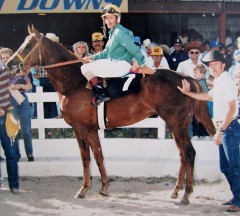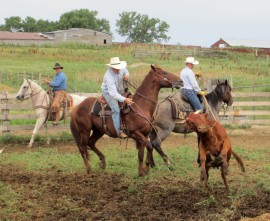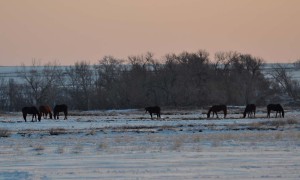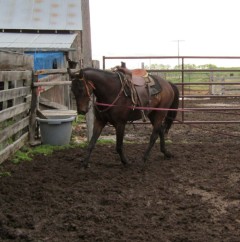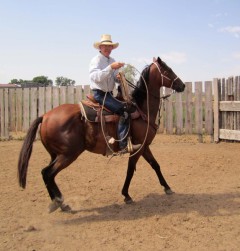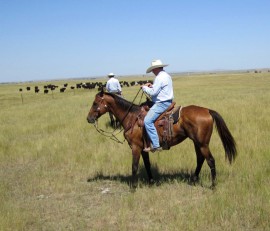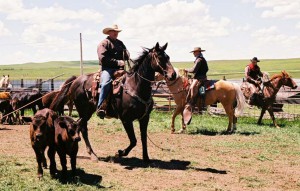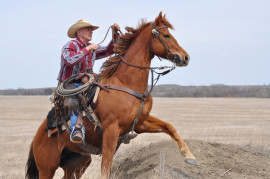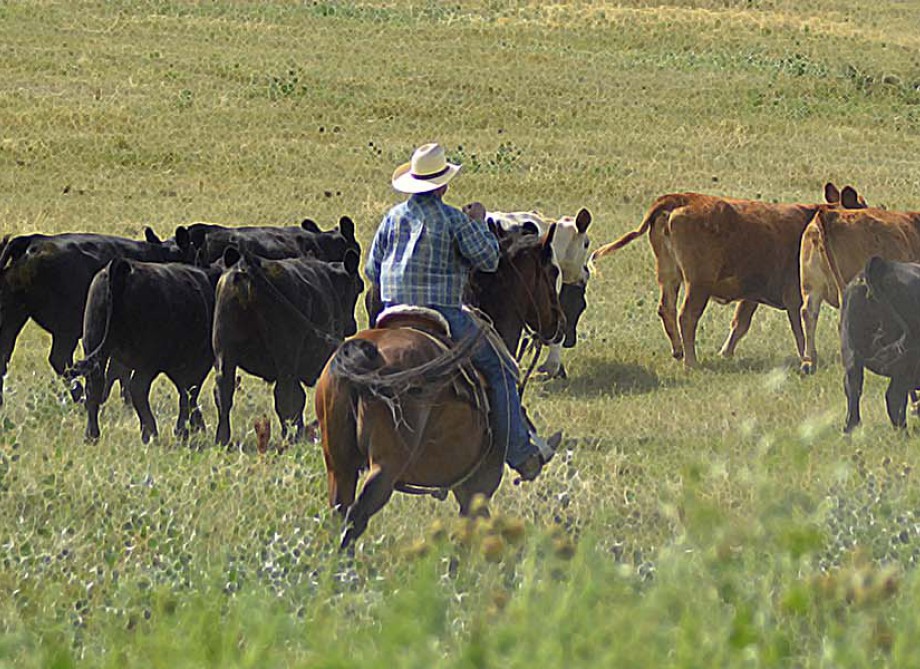
Our Training Program
Background:
The basic concept that became the Gate to Great training program was born of a need for our head trainer, Dale Simanton, to find a way to keep his racing string fresh while in training. During Dale's racing years, he held a trainer's license in several states in the Upper Midwest and took his string of Thoroughbreds from track to track throughout the spring to fall season. During the winters and in downtime between race meets, Dale discovered that by taking his Thoroughbreds back to the ranch and asking them to become part of the working ranch remuda, his horses stayed mentally and physically fresher than by staying in race training alone.
Not only did Dale's Thoroughbred string stay fresher, they left the track with a set of skills that made it easy for them to transition to a second career. Dale often had to fight the stereotype that "Thoroughbreds can't work cattle" and "Racehorses are all crazy", but the horses spoke for themselves, often outworking and outroping the specially-bred and trained Quarter Horses alongside them.
Dale left the track to concentrate his efforts on the Horse Creek Thoroughbred breeding program, but never forgot how well his Thoroughbreds did as ranch mounts. After acquiring the Meadowlake stallion Finn McCool for Horse Creek's broodmare band, Dale started using Finn as a ranch mount outside the breeding season. Not only did Finn relish the work, he became a noted horse on the ranch rodeo circuit, competing against all-Quarter Horse teams and quite often beating them.
In the late 2000's, the Thoroughbred breeding industry took a beating along with the rest of the economy. Dale and Dorothy starting brainstorming on ways to keep the ranch profitable and still support the Thoroughbred industry. Building upon their background of using their race horses as ranch horses, they developed the concept of "Great Geldings", first as a program they called "Great Plains Thoroughbred Advantage", which evolved into today's "Gate to Great."
How It Works:
We acquire geldings directly off the track through a network of trainers we have developed throughout the Midwest, but particularly the Kentucky and Florida circuits. Sometimes the horses find us, sometimes we search them out!
In a process we've dubbed "Un-Tracked Mind", new arrivals begin their post-racing life with introduction to turn out time, where they not only are able to "let down" physically, but mentally as well. Depending upon the horse's needs, they may spend anywhere from a month to a year in turn-out, before being re-started under saddle.
The steps in our process of re-training can vary from horse to horse and is often dictated by the seasons. Work can start on the ground, which includes long-line sessions and getting them used to the feel of Western tack as well as a flank cinch. In some cases, the horses head right out to the fields to be introduced to cattle. A light hand is used as they learn to accept a mild curb bit, yield to leg pressure, work gates and leave the barnyard for solo rides. Each step teaches them to work calmly and quietly, regardless of the surroundings.
Basic saddle work is soon followed by learning to get used to the rope, an important step before heading to brandings. The geldings are asked to allow the rope to fly all around their body, above their head and under their bellies, all without getting flustered. They learn to drag the rope on the ground, first by itself but soon attached to all manner of things...tires, posts, you name it. This is all in preparation for attached a calf to the end of that rope when they start "real" ranch work.
Actual cattle are introduced slowly, either in the arena or a pasture. Some horses march right up to them the first time, others need some time to figure out what these large, bellowing creatures are all about! To the surprise of many of our ranching neighbors, many of our off-track Thoroughbreds show plenty of "cowiness" from day one. That is, the ability and desire to herd and work around cattle...a trait normally thought to be reserved only for "cow-bred" stock horses. We have even had geldings that, when turned loose in a group of cattle, will naturally cut out a cow and begin "working" her all on their own!
Soon the geldings are asked to begin riding the "big" pastures, and by big we don't mean graduating to a 50 acre paddock...we mean 2,500 acre pastures, where you can't see the fencelines because they are literally miles away. Most racehorses, well most horses in general, have never been in spaces that wide open and they can initially get pretty excited by it...but that is where the cattle come in handy. By keeping their minds focused on the task at hand, in this case moving cattle from pasture to pasture, we allow them to learn to operate in the open while still concentrating on the work in front of them.
Throughout the course of a year of ranch work, the geldings are asked to perform in many different situations. During the spring, they may be asked to rope calves to be drug to the branding fire...where they must contend with open fires, milling and bawling cattle and dozens of other horses and riders. In the fall, they help gather cattle to be shipped to market, sometimes covering dozens of miles in a day in the roughest country.
In mid-summer, it might be checking the miles of fencelines...where they might be asked to stand quietly for an hour or more while a fence is fixed. In winter, they learn to navigate deep snow while checking cattle and sometimes moving them back to their home ranches after they wander in a snowstorm. At the end of their "course of work", there is little these horses have not seen or done.
What Can They Do From Here?
The mental and physical training provided by the ranch work in the Gate to Great program gives our geldings a firm foundation to successfully move into any discipline. Our horses have transitioned into careers as field hunters, show ring hunters/jumpers, dressage, eventing, endurance riding, trail pleasure, polo, barrel racing, roping and other western performance disciplines.
As many people already know, the heart and will to "try" makes Thoroughbreds outstanding mounts for just about anything. When you add a willing attitude to a training program that teaches them to calmly do the work in front of them, no matter the situation, you have a horse that can be a world-beater on any stage!

